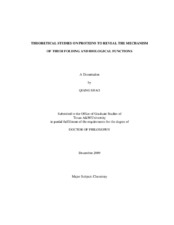| dc.contributor.advisor | Gao, Yi Qin | |
| dc.creator | Shao, Qiang | |
| dc.date.accessioned | 2011-02-22T22:23:50Z | |
| dc.date.accessioned | 2011-02-22T23:46:04Z | |
| dc.date.available | 2011-02-22T22:23:50Z | |
| dc.date.available | 2011-02-22T23:46:04Z | |
| dc.date.created | 2009-12 | |
| dc.date.issued | 2011-02-22 | |
| dc.date.submitted | December 2009 | |
| dc.identifier.uri | https://hdl.handle.net/1969.1/ETD-TAMU-2009-12-7395 | |
| dc.description.abstract | The folding mechanism of several β-structures (e.g., β-hairpins and β-sheets) was studied using newly developed enhanced sampling methods along with MD simulations in all implicit solvent environments. The influence of different implicit solvent models on the folding simulation of β-structure was also tested. Through the analysis of the free energy landscape as the function of several suitable reaction coordinates, we observed that the folding of β-hairpins is actually a two-state transition. In addition, the folding free energy landscapes for those related hairpins indicate the apparent sequence dependence, which demonstrates different folding mechanisms of similar β-structures of varied sequence. We also found that the stability of backbone hydrogen bonds is determined by the turn sequence and the composition of hydrophobic core cluster in β-structures. Neither of these findings was reported before.
The processive movement of kinesin was also studied at the mesoscopic level. We developed a simple physical model to understand the asymmetric hand-over-hand mechanism of the kinesin walking on the microtubule. The hand-over-hand motion of the conventional kinesin is reproduced in our model and good agreement is achieved between calculated and experimental results. The experimentally observed limping of the truncated kinesin is also perfectly described by our model.
The global conformational change of kinesin heads (e.g., the power stroke of neck-linkers which works as lever-arms during the kinesin walking, the transition between open and closed states of the switch region of the nucleotide binding domain in each head induced by the nucleotide binding and release) was studied for both dimeric and monomeric kinesins using a coarse-grained model, anisotropic network model (ANM). At the same time Langevin mode analysis was used to study the solvent influence on the motions of the kinesin head mimicked by ANM. Additionally, the correlation between the neck-linker and the nucleotide binding site was also studied for dimeric and monomeric kinesins. The former shows the apparent correlation between two subdomains whereas the latter does not, which may explain the experimental observation that only the dimeric kinesin is capable of walking processively on the microtubule. | en |
| dc.format.mimetype | application/pdf | |
| dc.language.iso | en_US | |
| dc.subject | B-hairpin folding | en |
| dc.subject | implicit solvent models | en |
| dc.subject | enhanced sampling method | en |
| dc.subject | sequence influence | en |
| dc.subject | kinesin | en |
| dc.subject | hand-over-hand mechanism | en |
| dc.subject | anisotropic network model | en |
| dc.subject | Langevin mode analysis | en |
| dc.title | Theoretical Studies on Proteins to Reveal the Mechanism of Their Folding and Biological Functions | en |
| dc.type | Book | en |
| dc.type | Thesis | en |
| thesis.degree.department | Chemistry | en |
| thesis.degree.discipline | Chemistry | en |
| thesis.degree.grantor | Texas A&M University | en |
| thesis.degree.name | Doctor of Philosophy | en |
| thesis.degree.level | Doctoral | en |
| dc.contributor.committeeMember | Lucchese, Robert R. | |
| dc.contributor.committeeMember | North, Simon W. | |
| dc.contributor.committeeMember | Li, Pingwei | |
| dc.type.genre | Electronic Dissertation | en |
| dc.type.material | text | en |


